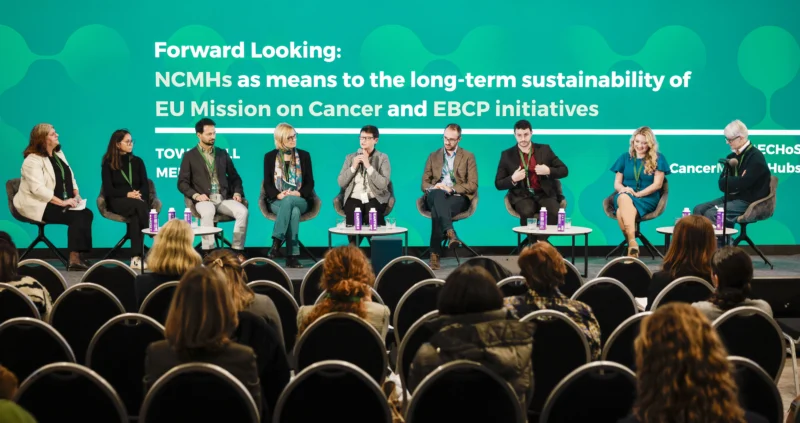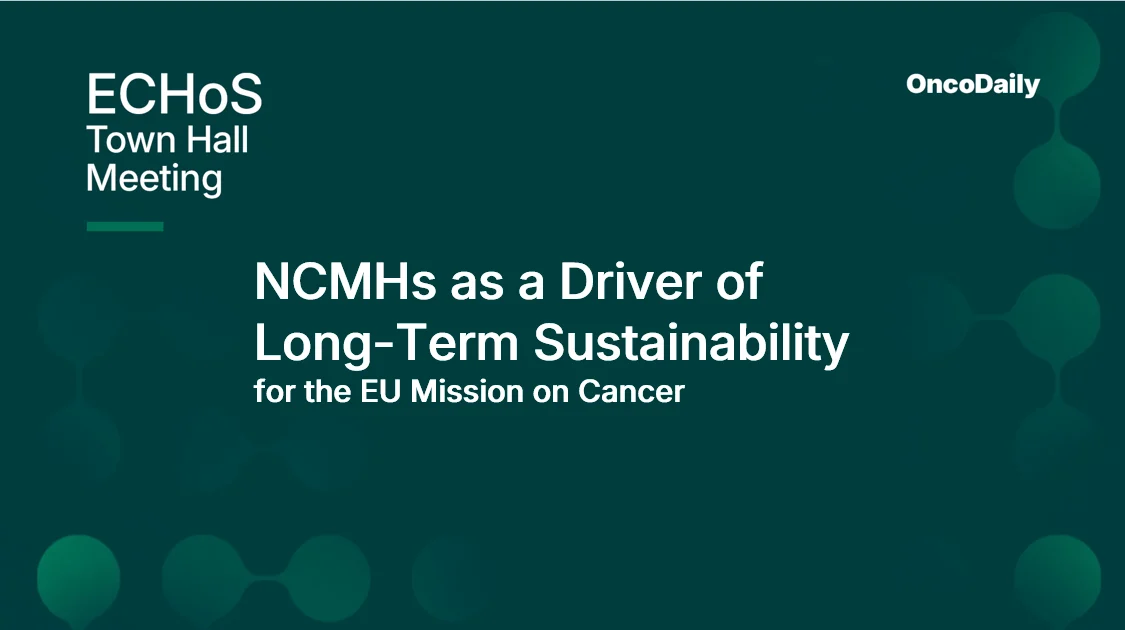At the ECHoS Town Hall Meeting, the session “NCMHs as Means to the Long-Term Sustainability of EU Mission on Cancer and EBCP Initiatives” explored how National Cancer Mission Hubs (NCMHs) are becoming essential pillars for sustaining Europe’s major cancer initiatives. As the EU Mission on Cancer and Europe’s Beating Cancer Plan (EBCP) transition from early implementation into long-term impact, hubs are increasingly seen as the structural engines capable of ensuring continuity, coherence, and collaboration across countries.

Bringing together leaders from EU institutions, national authorities, regional bodies, cancer institutes, and patient organisations, the discussion highlighted a shared vision: NCMHs are evolving into permanent coordination platforms that align policies, mobilize communities, and translate European ambitions into national and regional action.
A Sustainable Architecture for Europe’s Cancer Goals
The EU Mission on Cancer and the EBCP were designed as long-term transformation programmes rather than short-term research projects. Yet sustaining their impact requires mechanisms that continue operating beyond funding cycles and political changes.
NCMHs provide this continuity by acting as country-level anchors. They connect the Mission’s objectives with national cancer plans, regional ecosystems, patient needs, and on-the-ground realities. Instead of isolated initiatives, hubs create a sustainable architecture that keeps the Mission’s goals active, integrated, and evolving within each Member State.
From Pilot Projects to Long-Term Systems
One of the strongest messages of the session was the shift from projects to systems. NCMHs were initially launched through EU-funded programmes such as ECHoS, but they are quickly maturing into long-term structures.
Their value lies in how they:
- coordinate diverse stakeholders
- build trust across sectors
- enable co-creation of cancer strategies
- support policymakers with evidence
- maintain momentum during transitions.
This systemic approach ensures that the goals of the Mission and the EBCP do not fade once initial funding ends but remain embedded in national governance and community practice.
The Power of Multilevel Collaboration
The session highlighted that long-term sustainability depends on collaboration across levels of governance. Cancer control is not only a national responsibility; it is deeply rooted in regional health systems, municipal structures, academic networks, and local innovation ecosystems.
NCMHs help bridge these layers by:
- engaging regions that differ widely in resources and needs
- linking national plans with regional implementation
- connecting researchers, clinicians, and policymakers
- facilitating collaboration with industry, NGOs, and civil society.
This multilevel approach ensures that Europe’s cancer strategies remain responsive, inclusive, and grounded in local contexts.
Strengthening Implementation Capabilities
A recurring theme was the importance of implementation tools. While high-level strategies outline what should be achieved, hubs provide the structures for how to do it.
Key examples include:
- stakeholder engagement frameworks that help hubs convene diverse groups
- citizen and patient participation models ensuring community voices shape national priorities
- policy dialogues that create safe, structured spaces to break deadlocks and move systems toward decision points
- cross-country knowledge exchanges that allow hubs to learn from each other and adapt proven models
These tools help transform ambition into action — a critical requirement for long-term sustainability.
Embedding Equity and Citizen Engagement
Another cross-cutting message was the centrality of citizens and patients in building sustainable cancer systems. NCMHs increasingly serve as platforms where patient organisations stand on equal footing with policymakers, researchers, and health professionals.
This shift ensures that long-term strategies reflect the lived experiences of people affected by cancer, making them more relevant, equitable, and resilient. Sustainability, the session underscored, is not only about operational models but also about legitimacy and trust.
Institutional Anchoring for the Future
Many Member States are now integrating their hubs directly into national cancer institutes, public health structures, or regional governance bodies. This “institutional anchoring” allows hubs to function as stable, long-term entities rather than temporary initiatives.
By embedding hubs within permanent structures, countries strengthen their capacity to:
- coordinate screening, prevention, and treatment strategies
- support comprehensive cancer centre development
- integrate research and innovation into clinical pathways
- ensure alignment with European objectives over decades
This anchoring is emerging as a defining factor for sustainability.
A Collective Path Forward
The session closed with a unifying message: NCMHs are becoming Europe’s long-term coordination infrastructure for cancer.
They do not impose solutions but enable spaces where diverse stakeholders can think collectively, align priorities, and design pathways that work in real-world settings. Through collaboration, they accelerate progress and safeguard continuity.
As Europe advances toward its 2030 cancer goals and beyond, NCMHs are positioned to ensure that the Mission on Cancer and the EBCP remain impactful, credible, and sustainable — ultimately delivering lasting benefits for patients, health systems, and future generations.
For more information click here.
